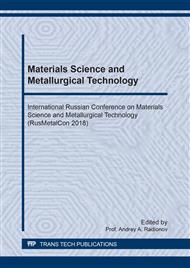[1]
M. Matsushita, T. Kuji, H. Kuroda, S. Aoyama, H. Ohfuji. EBSD Analysis of the Submicron Width Fibber Shaped Grain Copper Fabricated by Drawing, Mater. Sci. and App. 2 (2011) 911-916.
DOI: 10.4236/msa.2011.27121
Google Scholar
[2]
D. Guskovic, D. Markovic, S. Nestorovic, Effect of deformation and oxygen content on mechanical properties of different copper wires, Bulletin of Mater. Sci. 20(5) (1997) 693-697.
DOI: 10.1007/bf02745077
Google Scholar
[3]
G. H. Hasani, R. Mahmudi, A. Karimi-Taheri. On the strain inhomogeneity in drawn copper wires, Int. J. of Material Forming. 3 (2010) 59–64.
DOI: 10.1007/s12289-009-0417-9
Google Scholar
[4]
K. Hanazaki, N. Shigeiri, N. Tsuji. Change in microstructures and mechanical properties during deep wire drawing of copper, Mater. Sci. and Eng. A. 527 (2010) 5699–5707.
DOI: 10.1016/j.msea.2010.05.057
Google Scholar
[5]
Y.N. Loginov, S.L. Demakov, M.A. Ivanova, A.G. Illarionov, M.S. Karabanalov, S.I. Stepanov. Effect of annealing on properties of hot-rolled electrical copper, The Physics of Metals and Metallography. 116(4) (2015) 393-400.
DOI: 10.1134/s0031918x1502009x
Google Scholar
[6]
L.S. Vatrushin, V.G. Osintsev, A.S. Kozyrev. Beskislorodnaya med' [Oxygen-Free Copper] Moscow: Metallyrgia, (1982).
Google Scholar
[7]
S.L. Demakov, Yu.N. Loginov, A.G. Illarionov, M.A. Ivanova. [Texture formation at manufacturing stages of copper wire], Kabeli i provoda. 2 (2012) 8-12 (in Russ).
Google Scholar
[8]
M.A. Zorina, M.S. Karabanalov, S.I. Stepanov, S.L. Demakov, Y.N. Loginov, M.L. Lobanov Fiber vs. Rolling Texture: Stress State Dependence for Cold-Drawn Wire, Metallurgical, and Mater. Transactions A: Physical Metallurgy and Mat. Sci., 49A (2018) 427-433.
DOI: 10.1007/s11661-017-4423-0
Google Scholar
[9]
Y.N. Loginov, S.L. Demakov, A.G. Illarionov, M.A. Ivanova. Interaction of a copper oxide particle with copper in drawing, Russian Metallurgy (Metally). 11 (2012) 947-953.
DOI: 10.1134/s0036029512110109
Google Scholar
[10]
Yu.N. Loginov, S.L. Demakov, A.G. Illarionov, M.A. Ivanova, M.S. Karabanalov. [Origination of porous structures in oxygen-containing copper by deformation impact], Physical Mesomechanics. 16(6) (2013) 99-102 (in Russ).
Google Scholar
[11]
Yu.N. Loginov, S.L. Demakov, A.G. Illarionov, M.A. Ivanova, V.A. Romanov, Structural condition of copper wire rod, obtained during the continuous casting - Rolling process, Tsvetnye Metally. 8 (2013) 87-92.
Google Scholar
[12]
M. Schwarze, CONTIROD equipment for copper wire rod production: The highest quality for minimal expenses, Tsvetnye Metally. 4 (2005) 95-100.
Google Scholar
[13]
Metals. Methods of tension test. State All-Union standard GOST 1497-84 (ISO 6892−84, ST SEV 471−88), IPK Publishing house of standards (1984).
Google Scholar
[14]
Non-ferrous metals. Determination of grain size. General requirements. State All-Union standard GOST 21073.0-75, IPK Publishing house of standards (2002).
Google Scholar
[15]
H. Blumenauer. Materials Testing (in German), Leipzig, Grundstoffindustrie, (1976).
Google Scholar
[16]
M.A. Shtremel'. Prochnost' splavov. Chast' II: Deformatsiya [Strength of Alloys. Part II. Deformation]. Moscow, MISiS Publ., (1997).
Google Scholar
[17]
P.I. Polykhin, S.S. Gorelik, V.K. Vorontsov. Fizicheskiye osnovy plasticheskoy deformatsii [Physical fundamentals of plastic deformation], Moscow: Metallyrgia, (1982).
Google Scholar
[18]
O.E. Osintsev, V.N. Fedorov. Med' i mednyye splavy [Copper and copper alloys]. Moscow: Mashinostroyeniye, (2004).
Google Scholar
[19]
M.A. Shtremel'. Prochnost' splavov. Chast' I: Deformatsiya [Strength of Alloys. Part I. Deformation]. Moscow, MISiS Publ., (1999).
Google Scholar


